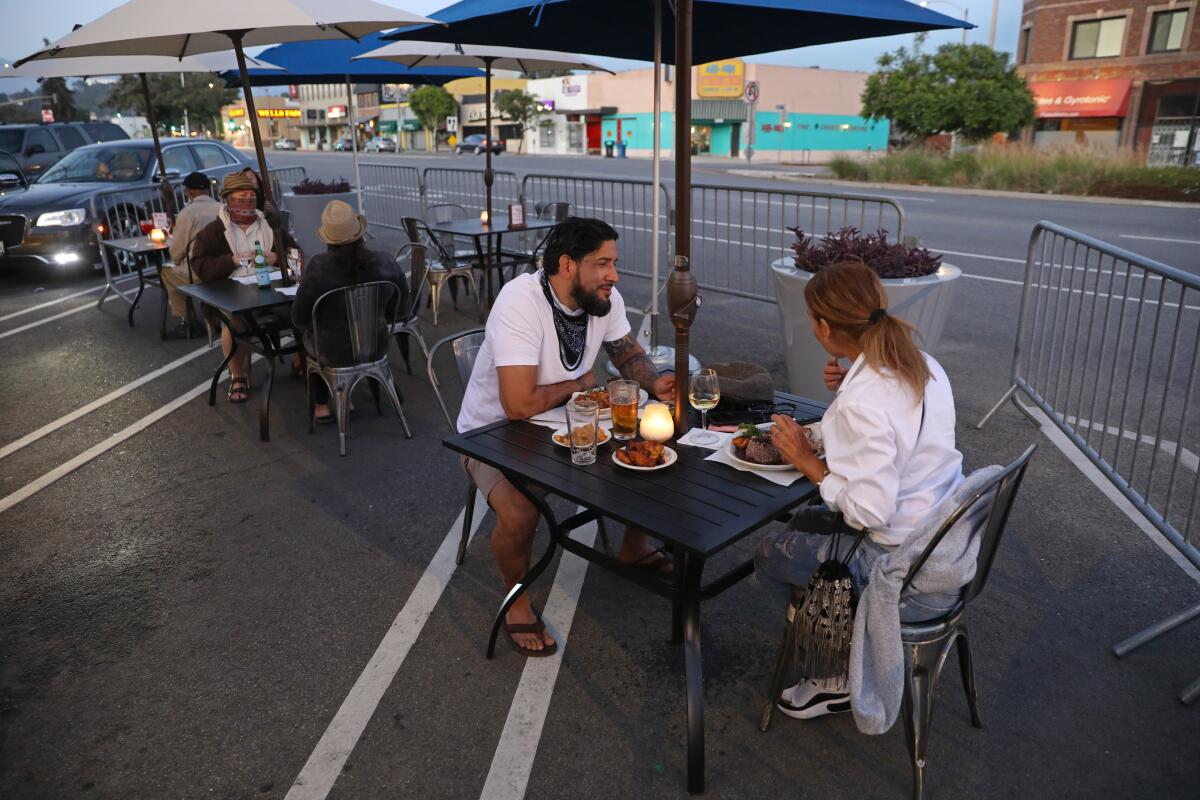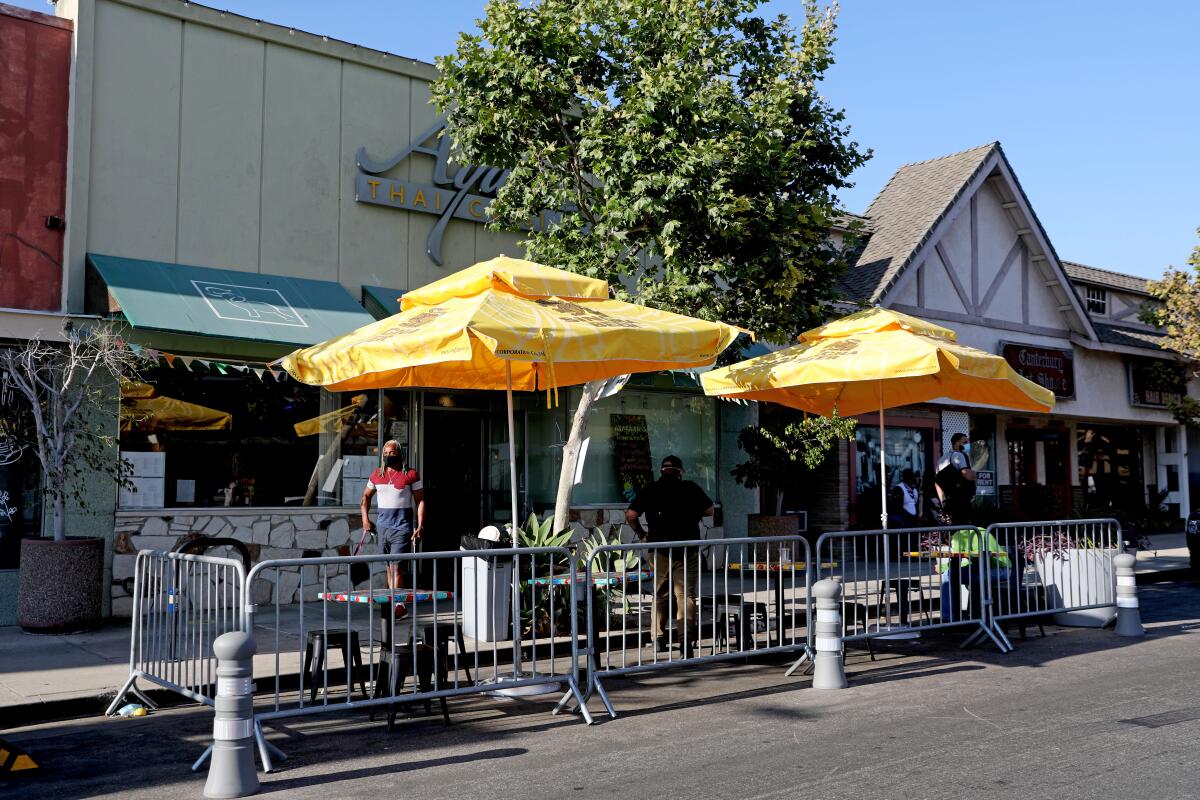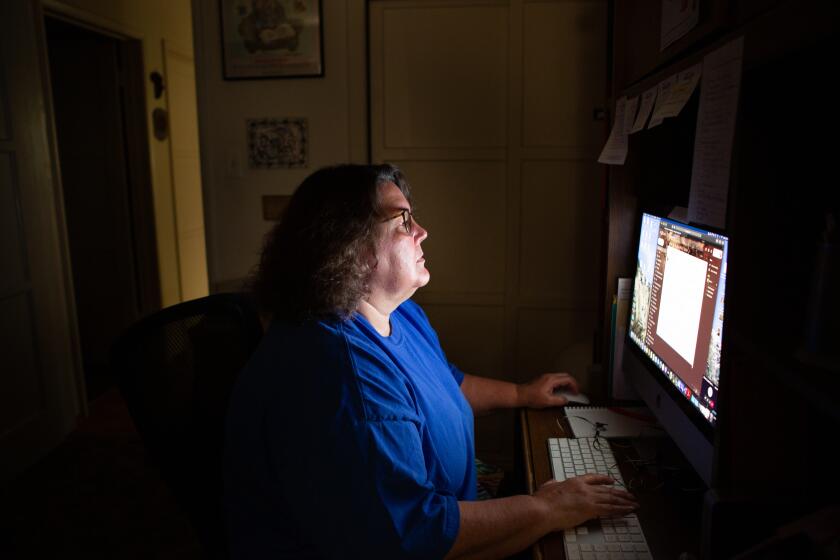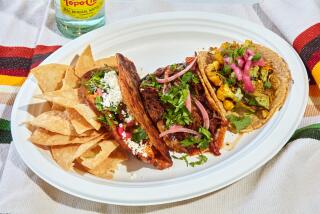L.A.-area parking spots have become dining areas during the pandemic. Will it last?

- Share via
On a balmy evening in Atwater Village, diners at candlelit tables shared plates of Cuban food and flights of beer, serenaded by an accordion player down the block.
The scene was almost romantic, but for one catch: The tables were a few feet from rush-hour traffic zipping past on Glendale Boulevard.
“A table in a parking space, I was a little surprised,” utility inspector Luis Castillo said as he and a co-worker ate blackened tilapia and arroz con pollo. “But it’s nice to sit down and eat.”
The COVID-19 pandemic has reshaped commutes, workplaces and schools. Now, Southern California’s street network, the region’s largest public space, is transforming, too.
With COVID-19 cases surging, and indoor dining banned, more than 20 cities have launched programs that allow struggling restaurants to use sidewalks, parking spaces and private lots to serve meals en plein air.
Pasadena narrowed parts of Colorado Boulevard to one lane in each direction to make room for tables, massive umbrellas and potted banana palms. Long Beach has converted more than 100 parking spaces into eating areas. And parts of downtown Whittier and Culver City have been closed to cars entirely.
In Los Angeles, nearly 1,300 restaurants have received permits to offer outdoor dining of some kind, including 46 that are setting up in parking spaces. The city is reviewing six applications to shut down a street, officials said.
The changes, rolled out in a matter of weeks, are among the most dramatic in decades for a region that rarely prioritizes pedestrians above the demands of rush-hour traffic. And the changes have been easier to put in place because traffic is far lighter than usual.
Whether Southern California’s expanded outdoor dining scene is a permanent shift, or will evaporate when diners can eat indoors again, is “the million-dollar question,” said Madeline Brozen, the deputy director of UCLA’s Lewis Center.
The pandemic has forced cities and businesses to be more nimble and experimental, she said, and allows them to think about the logistics and trade-offs in real time: “What’s going to bring us more customers? Is it that we have a place to sit outside, or that we have nearby parking?”
Los Angeles Mayor Eric Garcetti said outdoor dining areas could become permanent in areas that have “consensus about saying, ‘Hey, we can live with a couple fewer parking spaces if that means our local café has a little more land.’”
Adding more outdoor seating, he said, will give customers a chance to “enjoy what L.A. has in spades: great weather, amazing people and beautiful views.”
Dining on Southern California’s usually traffic-choked streets has received its fair share of ribbing, including from the satirical publication the Onion, which announced the launch of “open-air dining areas along the 101 Freeway median.”
Compared with curbside dining in New York, where curbside patios are adorned with millennial pink plywood, lush plantings and white picket fences, L.A.’s alfresco dining just isn’t as sexy.
Most dining areas are separated from moving traffic by heavy concrete barriers. Others are in parking garages, including the Glendale Galleria’s new food court, where tables are spaced far apart and placed on strips of fake grass.
“There’s a ‘protection against car collisions’ mindset that permeates a lot of our design in L.A.,” Brozen said.
Curbside dining in L.A. may be spartan, restaurant owners say, but what really matters is the extra capacity until Gov. Gavin Newsom allows indoor dining to resume.
Capuyo Cafe in Boyle Heights closed for three months at the start of the pandemic. When the 1st Street cafe reopened in May, sales were down 40%, barely enough to cover expenses, said co-owner Beatriz Zaragoza.
Librarians and other library staff in Los Angeles are becoming contact tracers.
Hoping to add more seating beyond the 600-square-foot shop, she asked L.A. City Hall to convert two loading zone spaces into a seating area. Already, she said, customers are buying more food because they have somewhere to sit.
“We don’t eat outside enough in L.A.,” Zaragoza said. “My staff, they feel a lot more comfortable with customers dining outside. And customers can get fresh air and some vitamin D. ”
Another dining area has popped up outside Xelas, a bar a few doors down. Other businesses on the block, wary of eliminating too much street parking, are in talks with the city to add an outdoor dining area at nearby Mariachi Plaza.

In late June, the owners of Ayara Thai Cuisine added a parklet on their quiet side street in Westchester. The restaurant isn’t offering table service, but allows people to eat their takeout at outdoor tables draped in floral oilcloth, shaded by yellow Singha umbrellas.
The space is so popular at dinnertime that customers wait in their cars until a table frees up, then swoop in with their food, said chef and owner Vanda Asapahu. The competition, she said, is “almost like the new version of looking for a parking spot.”
The restaurant is hosting a weekend of drive-in movies in their adjoining parking lot. The parklet will serve as a concession stand of sorts, offering Thai-style hot dogs, fried bananas and Lay’s spicy chili potato chips.
Asapahu said the restaurant wants to keep the parklet — and see one side of the street converted into outdoor dining.
For years, Whittier officials had hoped to renovate a block of historic downtown, widening sidewalks and adding outdoor seating, but balked at the $3.8-million price tag.
In late June, the city converted a three-block stretch of Greenleaf Avenue into a pedestrian-only street. Of 18 open restaurants, 14 have set up open-air dining areas on the asphalt, officials said.
Temporarily banning cars achieved the same effect as the city’s planned makeover, but for far less money, said Frank Medina, the president of the Whittier Uptown Assn. Most restaurants spent $2,000 to $3,000 outfitting their dining spaces with tables, umbrellas and planters — and doubled their capacity, he said.
“It’s the heart of our downtown,” City Manager Brian Saeki said. “It feels like it’s always been there.”
When some business owners complained that the restrictions were an inconvenience to elderly and disabled customers, the city rolled back some of the closures. A block and a half of Greenleaf remains closed to cars.
“I intend to pursue making it permanent,” Medina said. “It’s fun. It’s family-oriented. It just feels right.”
More to Read
Sign up for Essential California
The most important California stories and recommendations in your inbox every morning.
You may occasionally receive promotional content from the Los Angeles Times.












